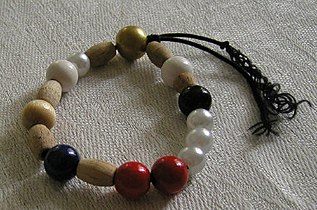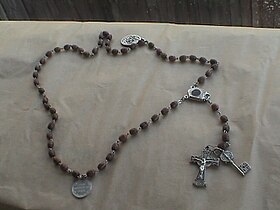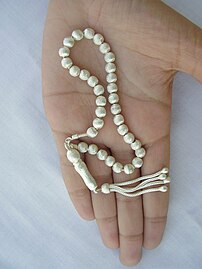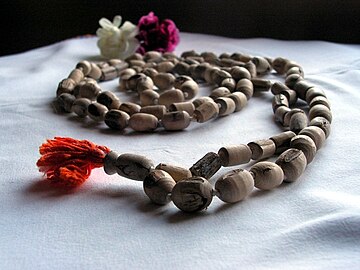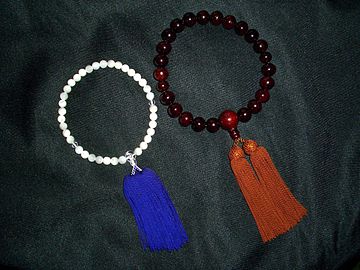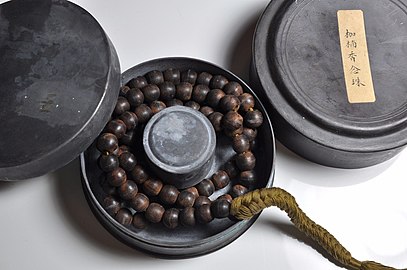Prayer beads
This article needs additional citations for verification. (May 2008) |
Prayer beads are a form of
Origins and etymology
Beads are among the earliest human ornaments and ostrich eggshell beads in Africa date to 10,000 BC.[1] Over the centuries various cultures have made beads from a variety of material from stone and shells to clay.[1]
The English word bead derives from the Old English noun bede which means a prayer.[2][3][4][5] The oldest image of a string of beads in a religious context and resembling a string of prayer beads is found on the fresco of the "Adorants" (or "Worshipers") at the Xeste 3 building of the prehistoric settlement of Akrotiri, Santorini (Thera,) Greece (Wall Paintings of Thera.)[6] dating from the 17th century BC (c. 1613 BC.) It was used in Hindu Prayers and meditation Hindu prayers in India.[citation needed] Buddhism later on adopted this custom.[citation needed] As the Ancient Hindus migrated towards West Asia this practice was carried to many parts of the world and became a part of different religions.[1][3][7] The statue of a Hindu holy man with beads dates to the third century BC.[3][7]
Structure
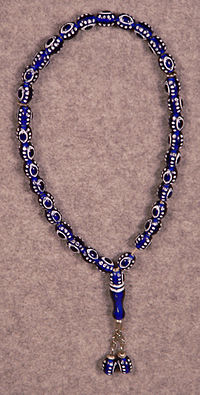
The number of beads varies by religion or use.
The oldest set of prayer beads in
The Greek "
Use
Since the beads are fingered in an automatic manner, they allow the user to keep track of how many prayers have been said with a minimal amount of conscious effort, which in turn allows greater attention to the prayer itself.
Judaism
Although the use of prayer beads grew within those religions, it did not enter Judaism, perhaps because of its association with other religions, and to date Judaism does not use prayer beads. Although not used as counting device, many Jews touch the knots on the tzitzits attached to their tallit (prayer shawl) at specific points in their prayers.[3]
Christianity
The Desert Fathers of the 3rd to 5th centuries, used pebbles or knotted ropes to count prayers, typically the Jesus Prayer ("Lord Jesus Christ, Son of God, have mercy on me, a sinner"). The invention is attributed to Anthony the Great or his associate Pachomius the Great in the 4th century. In Vita of Saint Paul of Thebes (227 AD to 342 AD), written by Saint Jerome (347 AD to 420 AD) it states that Saint Paul of Thebes used pebbles and knotted cord to count prayers.[9]
Around the 8th century,
In
The
The Lutheran Wreath of Christ,[18] invented by Martin Lönnebo, Bishop Emeritus of the Diocese of Linköping of the Swedish Lutheran Church, is a set of 18 beads, some round and some elongated, arranged in an irregular pattern. Each one has its own significance as a stimulus and reminder for meditation, although they can also be used for repetitive prayer.[19]
In the mid-1980s,
While there are liturgical churches using prayer beads in prayer, non-liturgical Christian churches do not use them.
Islam
In
Most currents of mainstream Islam consider the use of the misbaha in prayer and recitations to be an accepted practice.
-
A silver misbaha
-
A misbaha
Sikhism
Hinduism
An early use of prayer beads can be traced to
Japamala are used for repetition of a mantra, for other forms of sādhanā or "spiritual exercise" and as an aid to meditation. The most common mala have 108 beads.[28] The most common materials used for making the beads are Rudraksha seeds (used by Shaivites) and Ocimum tenuiflorum (tulasi) stems (used by Vaishnavites).[23] Other materials such as metals, seeds of a lotus and pearls are also used to make the beads.[29]
While using the prayer beads, one bead is moved at a time until arriving to the terminal bead. Once the terminal bead is touched, the prayer beads are reversed and counted in the opposite direction. It is held in a particular manner using the middle finger and thumb only, deliberately avoiding the use of the index finger - considering it to be inauspiciousness. The user also covers the prayer beads with a cloth called bag called "gomukha."[29]
Buddhism
Prayer beads (
Various type of materials are used to make mala beads such as seeds of the rudraksha, beads made from the wood of the tulsi plant, animal bone, wood or seeds from the Bodhi Tree (a particularly sacred tree of the species Ficus religiosa) or of Nelumbo nucifera (the lotus plant). Semi-precious stones like carnelian and amethyst are also used. Another commonly used material is sandalwood.[30]
Bahá’í Faith
The Baháʼí Faith stipulates that the verse Alláh-u-Abhá "God the All-Glorious" be recited 95 times daily after the performance of ablutions.[31] To help facilitate this recitation Bahá’ís often use prayer beads, though they are not required to. Most commonly, Bahá’í prayer beads consist of 95 individual beads on a strand or a strand of 19 beads with 5 set counters. In the latter case, the person reciting the verses typically tracks the 19 individual verses in a set with one hand and tracks the sets of verses with the other (19 verses times 5 sets for a total of 95 total verses). Bahá’í prayer beads are made of any number of natural and man-made materials including glass, precious and semi-precious stones, various metals and wood. There are no traditions regarding the structure of the prayer bead strand or the materials used.
Materials used for making prayer beads
Seeds and fruitstones
- Abrus precatorius
- Afzelia species
- Choerospondias axillaris
- Dracontomelon dao
- Rudraksha
- Vyjanti
Gems and precious stones
See also
References
- ^ ISBN 1-85973-995-4page 1
- ISBN 1-85326-311-7page 38
- ^ ISBN 0-8192-2276-3pages 4-10
- ISBN 1-85973-995-4page 76
- ISBN 0-8192-2321-2pages 134-136
- ^ "Archived copy". Archived from the original on 2 August 2018. Retrieved 29 December 2016.
{{cite web}}: CS1 maint: archived copy as title (link) - ^ ISBN 1-59276-929-2OSV Publishers pages 11-13
- ^ a b "Anglican Prayer Beads". Archived from the original on 19 December 2010. Retrieved 24 December 2010.
- ISBN 9781610695664. Archivedfrom the original on 27 March 2023. Retrieved 19 October 2020.
- ISBN 978-0-8122-0885-6.
- ^ "Pater Noster Cords". Solitaries of DeKoven. Archived from the original on 29 March 2022. Retrieved 10 March 2022.
Monks and clergy recited or chanted the Psalms as a major source of hourly worship. People living near the monasteries/abbeys realized the beauty of this devotion but unable to read or memorize the lengthy Psalms, the people were unable to adapt this form of prayer for their use. It was suggested that the people might substitute 150 Our Fathers in place of the Psalms.
- ^ a b c Thurston, Herbert; Shipman, Andrew (1912). "The Rosary". The Catholic Encyclopedia. Vol. 13. New York: Robert Appleton Company. Archived from the original on 3 July 2014. Retrieved 11 July 2014.
- ^ a b Volz, John (1907). "Use of Beads at Prayers". The Catholic Encyclopedia. Vol. 2. New York: Robert Appleton Company. Archived from the original on 1 July 2014. Retrieved 11 July 2014.
- ISBN 978-1-108-04886-6. Retrieved 11 July 2014.
- ^ Dalya Alberge (26 June 2022). "First ever prayer beads from medieval Britain discovered". The Telegraph. Archived from the original on 26 June 2022. Retrieved 26 June 2022.
- ^ "St Dominic & the Rosary". catholic-pages.com. Archived from the original on 7 April 2011. Retrieved 21 January 2018.
- ^ Prayer beads in Christianity Archived 24 June 2021 at the Wayback Machine Retrieved 18 December 2008
- ^ Pearls of Life Archived 21 August 2010 at the Wayback Machine Retrieved on 9 March 2010
- ^ Lerner, Thomas (2 February 2015). "Så blev Frälsarkransen Sveriges första moderna radband". Dagens Nyheter (in Swedish). Archived from the original on 27 March 2023. Retrieved 12 August 2016.
- ^ "Is Using Prayer Beads An Innovation? - SeekersHub Answers". 11 September 2009. Archived from the original on 2 October 2016. Retrieved 28 September 2016.
- ^ "Why do Ahmadi Muslims not use Tasbeeh (prayer beads)?". askislam.org. Archived from the original on 18 August 2014. Retrieved 7 April 2014.
- ^ "How Are Mala Rosary Prayer Beads Used in Sikhism?". about.com. Archived from the original on 5 March 2016. Retrieved 21 January 2018.
- ^ JSTOR 1255280– via JSTOR.
- ^ Untracht, Oppi (2008). "Rosaries of India". Traditional Jewelry of India. Archived from the original on 23 January 2012. Retrieved 14 January 2012.
- ^ "Hindu Malas". dharma-beads.net. Archived from the original on 21 January 2018. Retrieved 21 January 2018.
- ^ "Prayer Beads". dharma-beads.net. Archived from the original on 28 January 2012. Retrieved 21 January 2018.
- ^ Apte, Vaman Shivaram. A Practical Sanskrit Dictionary. p. 1267. Archived from the original on 15 December 2012.
- ^ The Significance of the number 108. Archived from the original on 13 August 2010. Retrieved 23 December 2007.
- ^ JSTOR 42931265– via JSTOR.
- ^ Prayer beads in Buddhism Archived 16 May 2015 at the Wayback Machine Retrieved 18 December 2008
- ISBN 0-85398-999-0.
Bibliography
- Dubin, L.S. (2009). Prayer Beads. In C. Kenney (Ed.), The History of Beads: From 100,000 B.C. to the Present (Revised and Expanded Edition) (pp. 79–92). New York: Abrams Publishing.
- Henry, G., & Marriott, S. (2008). Beads of Faith: Pathways to Meditation and Spirituality Using Rosaries, Prayer Beads and Sacred Words. Fons Vitae Publishing.
- Untracht, O. (2008). Rosaries of India. In H. Whelchel (Ed.), Traditional Jewelry of India (pp. 69–73). New York: Thames & Hudson, Inc.
- Wiley, E., & Shannon, M.O. (2002). A String and a Prayer: How to Make and Use Prayer Beads. Red Wheel/Weiser, LLC.
- Winston, K. (2008). Bead One, Pray Too: A Guide to Making and Using Prayer Beads. Morehouse Publishing.
- prayer beads Archived 24 June 2020 at the Wayback Machine.
External links
![]() Media related to Prayer beads at Wikimedia Commons
Media related to Prayer beads at Wikimedia Commons
- Anthropology of beads Museum of Anthropology, University of Missouri




